flat tire TOYOTA YARIS 2022 Owners Manual
[x] Cancel search | Manufacturer: TOYOTA, Model Year: 2022, Model line: YARIS, Model: TOYOTA YARIS 2022Pages: 590, PDF Size: 128.6 MB
Page 3 of 590

1
6
5
4
3
2
7
8
HV Owner's Manual_Europe_M52N30_en
Pictorial indexSearch by illustration
For safety
and security
Make sure to read through them
(Main topics: Child seat, theft deterrent system)
Vehicle status
information and
indicators
Reading driving-related information
(Main topics: Meters, multi-information display)
Before driving
Opening and closing the doors and windows, adjustment
before driving
(Main topics: Keys, doors, seats, power windows)
DrivingOperations and advice which are necessary for driving
(Main topics: Starting hybrid system, refueling)
Interior featuresUsage of the interior features
(Main topics: Air conditioner, storage features)
Maintenance
and care
Caring for your vehicle and maintenance procedures
(Main topics: Interior and exterior, light bulbs)
When trouble
arises
What to do in case of malfunction and emergency
(Main topics: 12-volt battery discharge, flat tire)
Vehicle
specifications
Vehicle specifications, customizable features
(Main topics: Fuel, oil, tire inflation pressure)
IndexSearch by symptom
Search alphabetically
Page 6 of 590
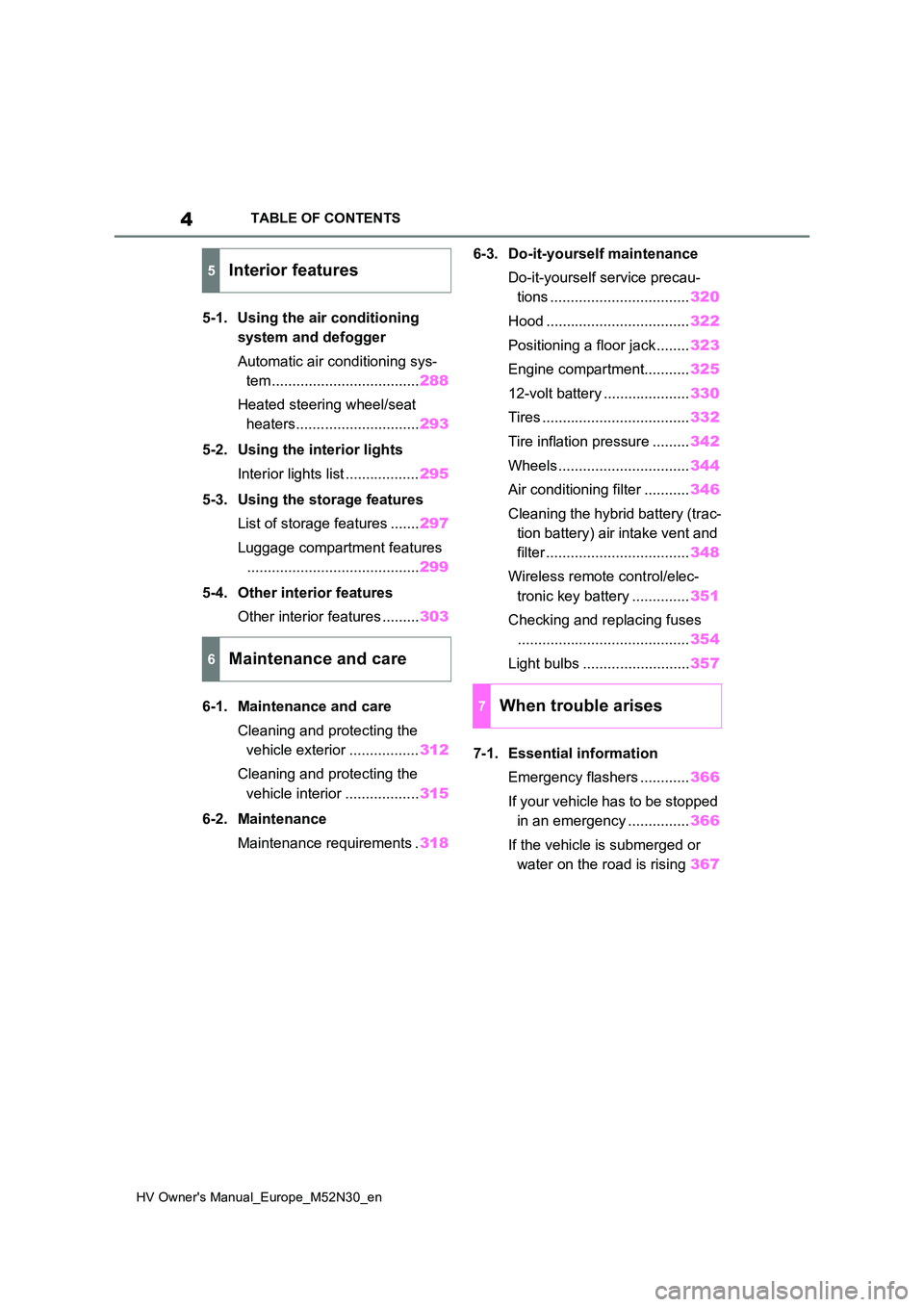
4
HV Owner's Manual_Europe_M52N30_en
TABLE OF CONTENTS
5-1. Using the air conditioning
system and defogger
Automatic air conditioning sys-
tem .................................... 288
Heated steering wheel/seat
heaters.............................. 293
5-2. Using the interior lights
Interior lights list .................. 295
5-3. Using the storage features
List of storage features ....... 297
Luggage compartment features
.......................................... 299
5-4. Other interior features
Other interior features ......... 303
6-1. Maintenance and care
Cleaning and protecting the
vehicle exterior ................. 312
Cleaning and protecting the
vehicle interior .................. 315
6-2. Maintenance
Maintenance requirements . 318
6-3. Do-it-yourself maintenance
Do-it-yourself service precau-
tions .................................. 320
Hood ................................... 322
Positioning a floor jack ........ 323
Engine compartment........... 325
12-volt battery ..................... 330
Tires .................................... 332
Tire inflation pressure ......... 342
Wheels ................................ 344
Air conditioning filter ........... 346
Cleaning the hybrid battery (trac-
tion battery) air intake vent and
filter ................................... 348
Wireless remote control/elec-
tronic key battery .............. 351
Checking and replacing fuses
.......................................... 354
Light bulbs .......................... 357
7-1. Essential information
Emergency flashers ............ 366
If your vehicle has to be stopped
in an emergency ............... 366
If the vehicle is submerged or
water on the road is rising 367
5Interior features
6Maintenance and care
7When trouble arises
Page 7 of 590
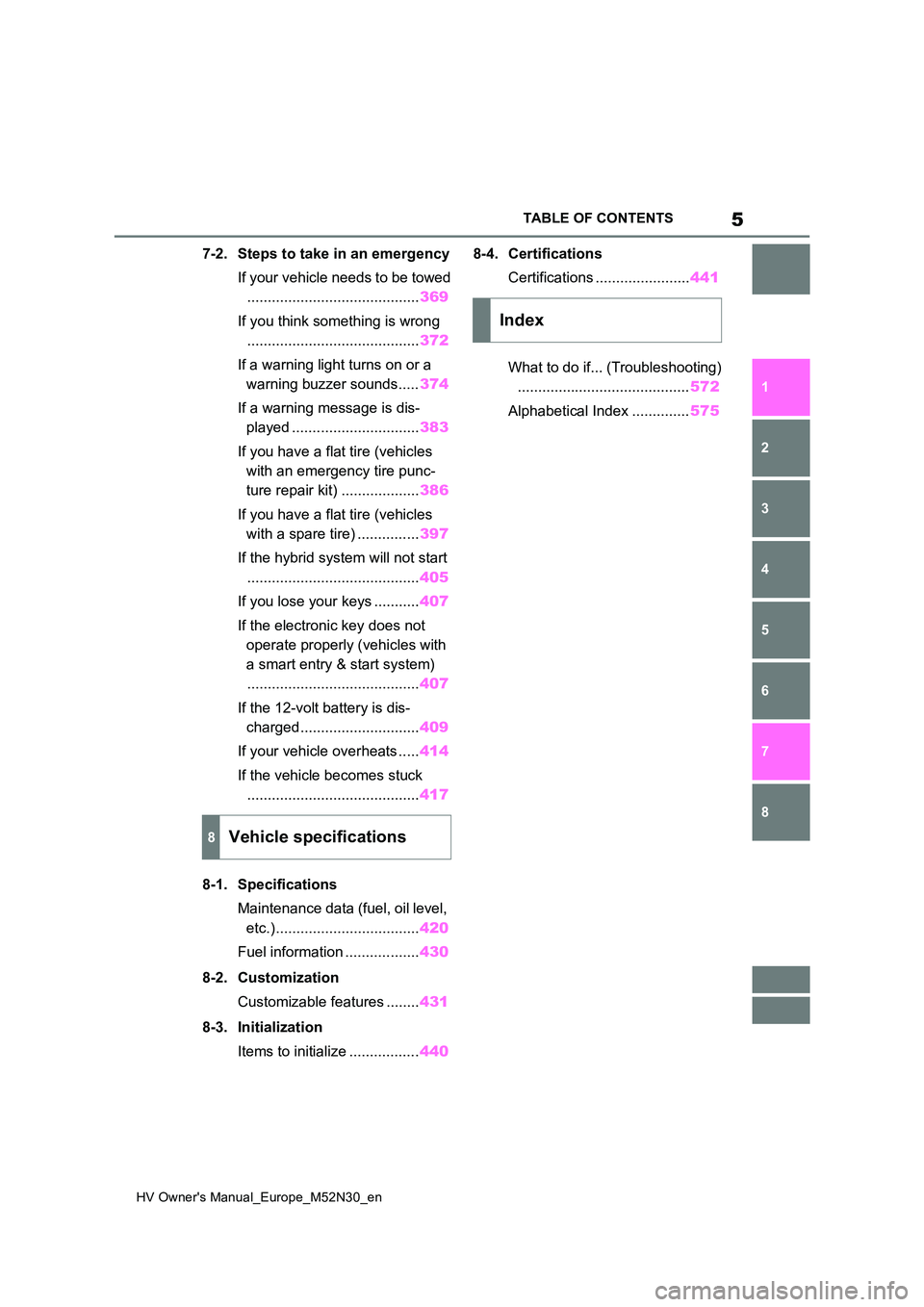
5
HV Owner's Manual_Europe_M52N30_en
TABLE OF CONTENTS
1
6
5
4
3
2
8
7
7-2. Steps to take in an emergency
If your vehicle needs to be towed
.......................................... 369
If you think something is wrong
.......................................... 372
If a warning light turns on or a
warning buzzer sounds..... 374
If a warning message is dis-
played ............................... 383
If you have a flat tire (vehicles
with an emergency tire punc-
ture repair kit) ................... 386
If you have a flat tire (vehicles
with a spare tire) ............... 397
If the hybrid system will not start
.......................................... 405
If you lose your keys ........... 407
If the electronic key does not
operate properly (vehicles with
a smart entry & start system)
.......................................... 407
If the 12-volt battery is dis-
charged............................. 409
If your vehicle overheats ..... 414
If the vehicle becomes stuck
.......................................... 417
8-1. Specifications
Maintenance data (fuel, oil level,
etc.)................................... 420
Fuel information .................. 430
8-2. Customization
Customizable features ........ 431
8-3. Initialization
Items to initialize ................. 440
8-4. Certifications
Certifications ....................... 441
What to do if... (Troubleshooting)
.......................................... 572
Alphabetical Index .............. 575
8Vehicle specifications
Index
Page 15 of 590
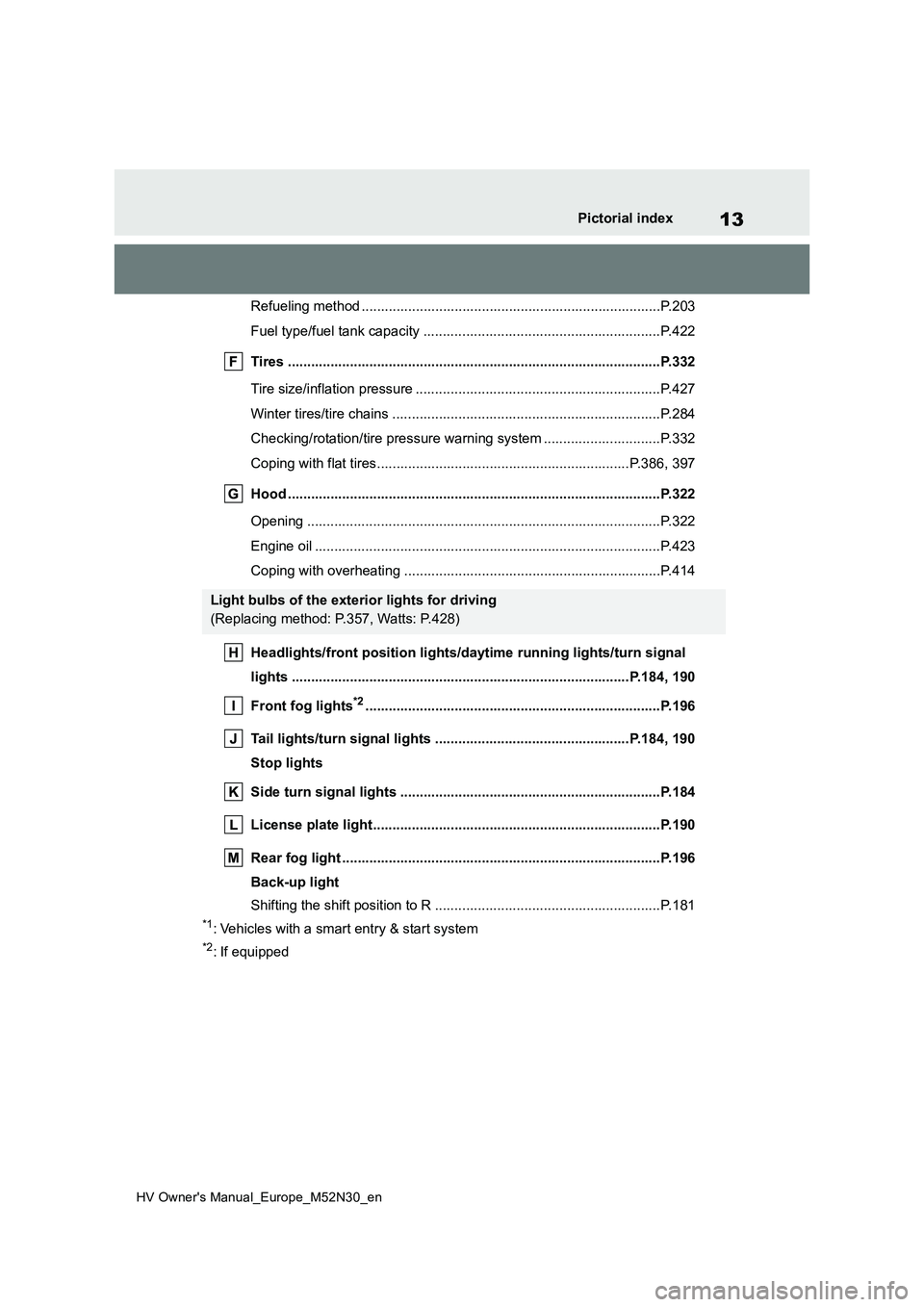
13
HV Owner's Manual_Europe_M52N30_en
Pictorial index
Refueling method .............................................................................P.203
Fuel type/fuel tank capacity ................................... ..........................P.422
Tires .......................................................... ......................................P.332
Tire size/inflation pressure ................................... ............................P.427
Winter tires/tire chains ....................................... ..............................P.284
Checking/rotation/tire pressure warning system ................. .............P.332
Coping with flat tires......................................... ........................P.386, 397
Hood ........................................................... .....................................P.322
Opening ........................................................ ...................................P.322
Engine oil ..................................................... ....................................P.423
Coping with overheating ........................................ ..........................P.414
Headlights/front position lights/daytime running lights/turn si gnal
lights ......................................................... ..............................P.184, 190
Front fog lights*2............................................................... .............P.196
Tail lights/turn signal lights ................................. .................P.184, 190
Stop lights
Side turn signal lights ........................................ ...........................P.184
License plate light............................................ ..............................P.190
Rear fog light ................................................. .................................P.196
Back-up light
Shifting the shift position to R ............................... ...........................P.181
*1: Vehicles with a smart entry & start system
*2: If equipped
Light bulbs of the exterior lights for driving
(Replacing method: P.357, Watts: P.428)
Page 167 of 590
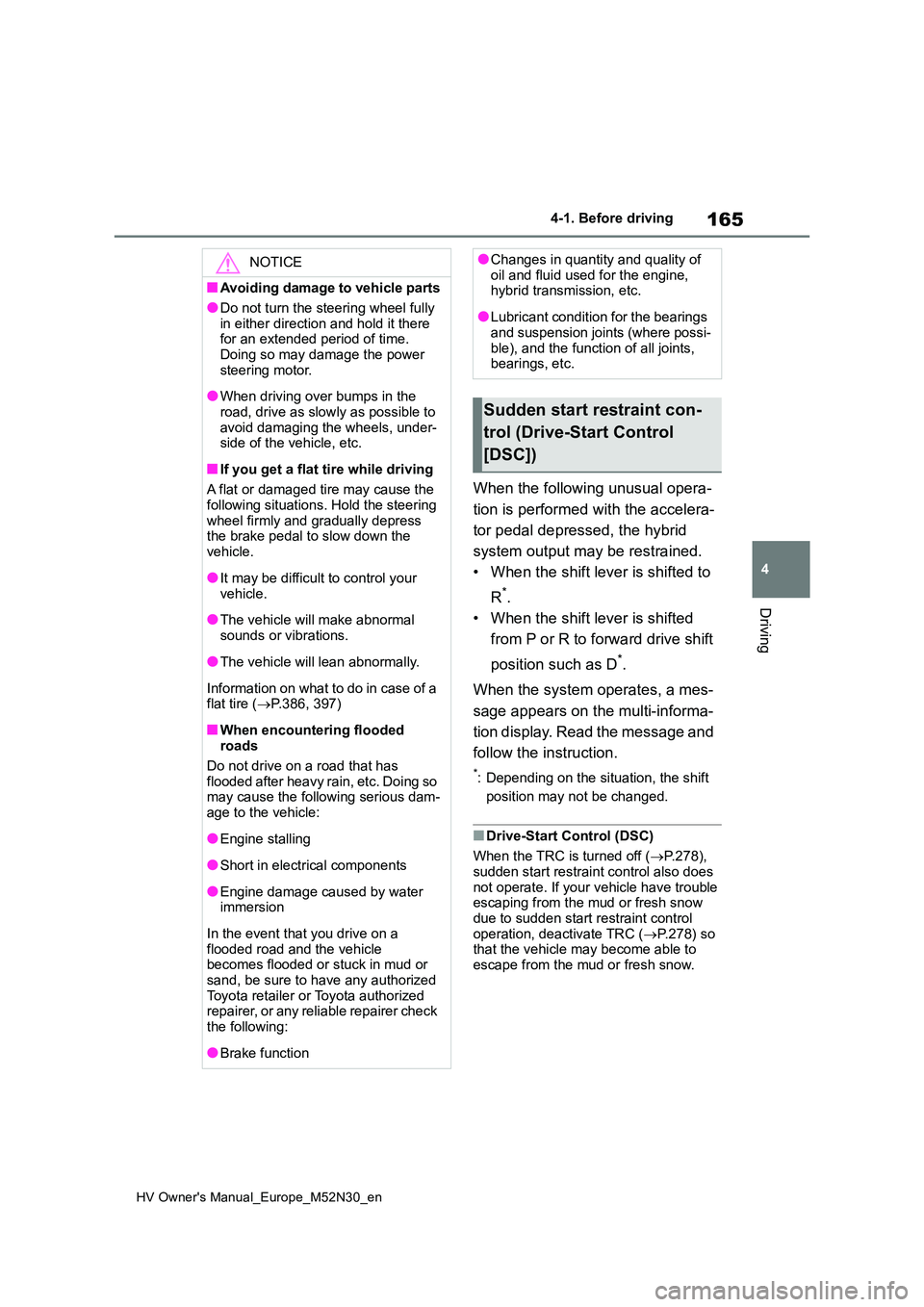
165
4
HV Owner's Manual_Europe_M52N30_en
4-1. Before driving
Driving
When the following unusual opera-
tion is performed with the accelera-
tor pedal depressed, the hybrid
system output may be restrained.
• When the shift lever is shifted to
R*.
• When the shift lever is shifted
from P or R to forward drive shift
position such as D*.
When the system operates, a mes-
sage appears on the multi-informa-
tion display. Read the message and
follow the instruction.
*: Depending on the situation, the shift
position may not be changed.
■Drive-Start Control (DSC)
When the TRC is turned off ( P.278),
sudden start restraint control also does not operate. If your vehicle have trouble escaping from the mud or fresh snow
due to sudden start restraint control operation, deactivate TRC ( P.278) so that the vehicle may become able to
escape from the mud or fresh snow.
NOTICE
■Avoiding damage to vehicle parts
●Do not turn the steering wheel fully
in either direction and hold it there for an extended period of time.Doing so may damage the power
steering motor.
●When driving over bumps in the
road, drive as slowly as possible to avoid damaging the wheels, under-side of the vehicle, etc.
■If you get a flat tire while driving
A flat or damaged tire may cause the
following situations. Hold the steering wheel firmly and gradually depress the brake pedal to slow down the
vehicle.
●It may be difficult to control your
vehicle.
●The vehicle will make abnormal
sounds or vibrations.
●The vehicle will lean abnormally.
Information on what to do in case of a flat tire ( P.386, 397)
■When encountering flooded roads
Do not drive on a road that has flooded after heavy rain, etc. Doing so may cause the following serious dam-
age to the vehicle:
●Engine stalling
●Short in electrical components
●Engine damage caused by water immersion
In the event that you drive on a flooded road and the vehicle becomes flooded or stuck in mud or
sand, be sure to have any authorized Toyota retailer or Toyota authorized repairer, or any reliable repairer check
the following:
●Brake function
●Changes in quantity and quality of oil and fluid used for the engine, hybrid transmission, etc.
●Lubricant condition for the bearings and suspension joints (where possi-
ble), and the function of all joints, bearings, etc.
Sudden start restraint con-
trol (Drive-Start Control
[DSC])
Page 171 of 590
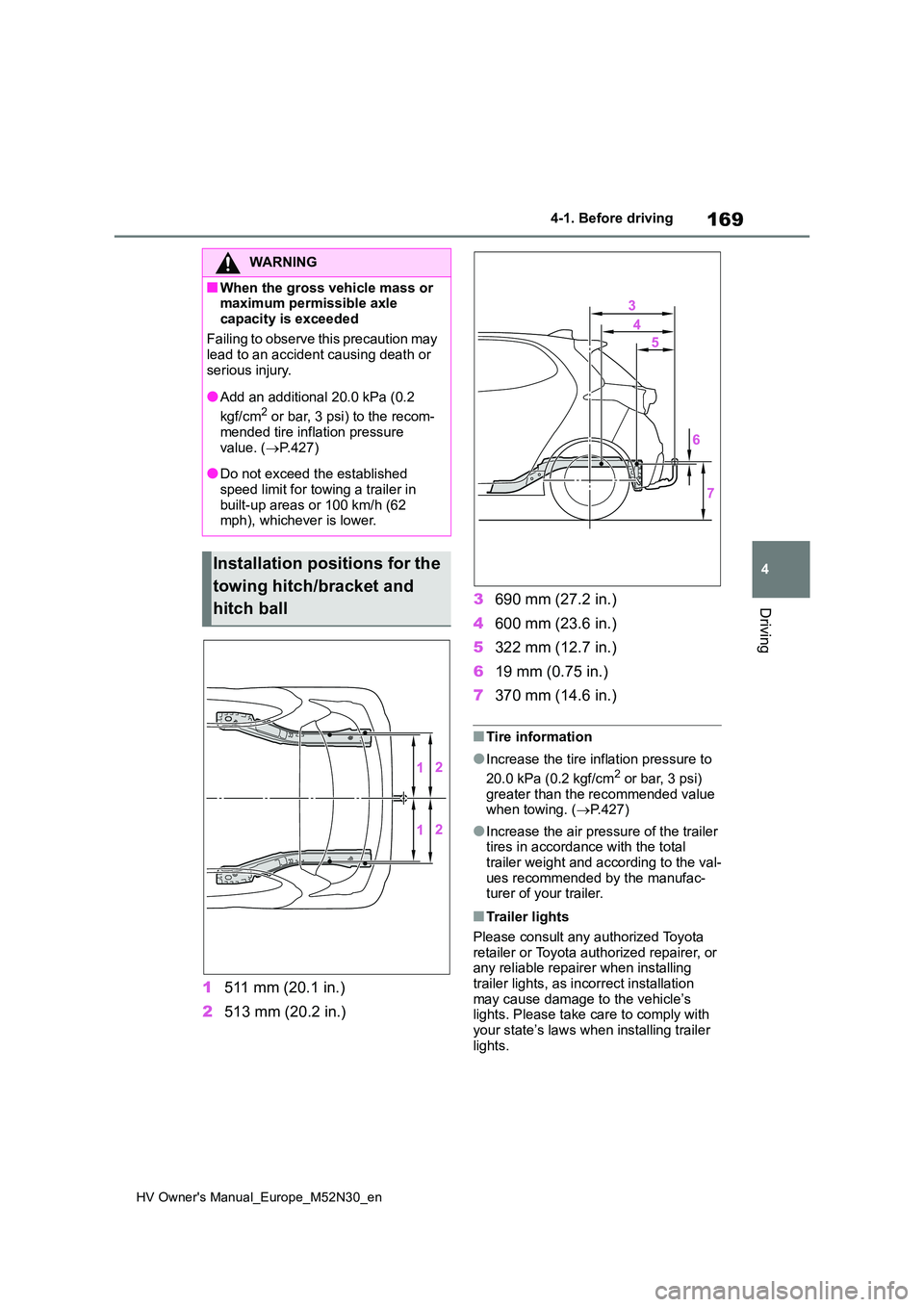
169
4
HV Owner's Manual_Europe_M52N30_en
4-1. Before driving
Driving
1511 mm (20.1 in.)
2 513 mm (20.2 in.)
3 690 mm (27.2 in.)
4 600 mm (23.6 in.)
5 322 mm (12.7 in.)
6 19 mm (0.75 in.)
7 370 mm (14.6 in.)
■Tire information
●Increase the tire inflation pressure to
20.0 kPa (0.2 kgf/cm2 or bar, 3 psi) greater than the recommended value when towing. ( P.427)
●Increase the air pressure of the trailer tires in accordance with the total
trailer weight and according to the val- ues recommended by the manufac-turer of your trailer.
■Trailer lights
Please consult any authorized Toyota retailer or Toyota authorized repairer, or any reliable repairer when installing
trailer lights, as incorrect installation may cause damage to the vehicle’s lights. Please take care to comply with
your state’s laws when installing trailer lights.
WARNING
■When the gross vehicle mass or maximum permissible axle
capacity is exceeded
Failing to observe this precaution may lead to an accident causing death or
serious injury.
●Add an additional 20.0 kPa (0.2
kgf/cm2 or bar, 3 psi) to the recom- mended tire inflation pressure
value. ( P.427)
●Do not exceed the established
speed limit for towing a trailer in built-up areas or 100 km/h (62 mph), whichever is lower.
Installation positions for the
towing hitch/bracket and
hitch ball
Page 197 of 590
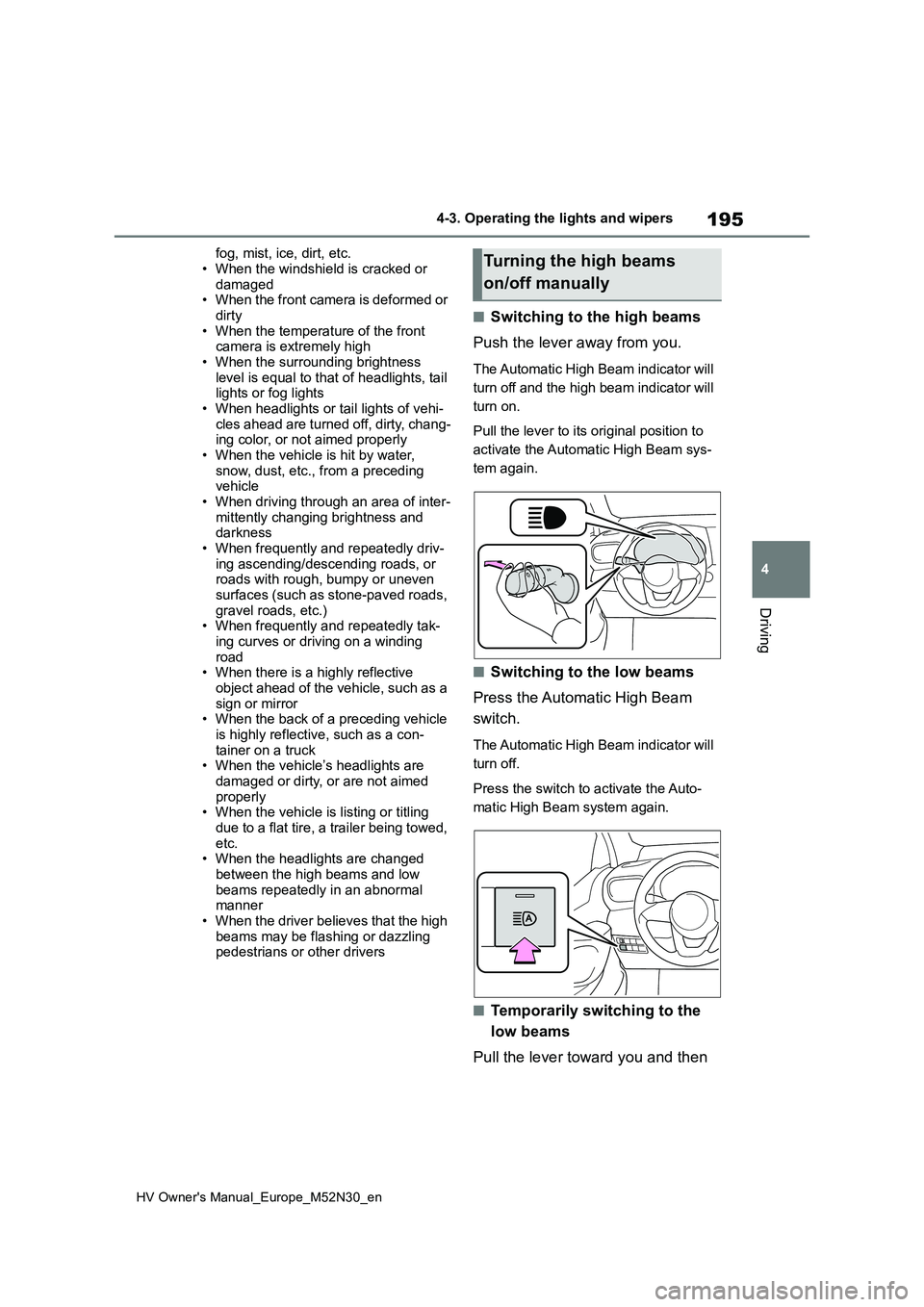
195
4
HV Owner's Manual_Europe_M52N30_en
4-3. Operating the lights and wipers
Driving
fog, mist, ice, dirt, etc.
• When the windshield is cracked or damaged• When the front camera is deformed or
dirty • When the temperature of the front camera is extremely high
• When the surrounding brightness level is equal to that of headlights, tail lights or fog lights
• When headlights or tail lights of vehi- cles ahead are turned off, dirty, chang-ing color, or not aimed properly
• When the vehicle is hit by water, snow, dust, etc., from a preceding vehicle
• When driving through an area of inter- mittently changing brightness and darkness
• When frequently and repeatedly driv- ing ascending/descending roads, or roads with rough, bumpy or uneven
surfaces (such as stone-paved roads, gravel roads, etc.)• When frequently and repeatedly tak-
ing curves or driving on a winding road• When there is a highly reflective
object ahead of the vehicle, such as a sign or mirror• When the back of a preceding vehicle
is highly reflective, such as a con- tainer on a truck• When the vehicle’s headlights are
damaged or dirty, or are not aimed properly• When the vehicle is listing or titling
due to a flat tire, a trailer being towed, etc.• When the headlights are changed
between the high beams and low beams repeatedly in an abnormal manner
• When the driver believes that the high beams may be flashing or dazzling pedestrians or other drivers
■Switching to the high beams
Push the lever away from you.
The Automatic High Beam indicator will
turn off and the high beam indicator will
turn on.
Pull the lever to its original position to
activate the Automatic High Beam sys-
tem again.
■Switching to the low beams
Press the Automatic High Beam
switch.
The Automatic High Beam indicator will
turn off.
Press the switch to activate the Auto-
matic High Beam system again.
■Temporarily switching to the
low beams
Pull the lever toward you and then
Turning the high beams
on/off manually
Page 214 of 590

212
HV Owner's Manual_Europe_M52N30_en
4-5. Using the driving support systems
■Enabling/disabling the pre-col-
lision system
The pre-collision system can be
enabled/disabled on ( P.431)
of the multi-information display.
The system is automatically enabled
each time the power switch is turned to
ON.
If the system is disabled, the PCS
warning light will turn on and a
message will be displayed on the
multi-information display.
■Changing the pre-collision
warning timing
The pre-collision warning timing
can be changed on ( P.431) of
the multi-information display.
The warning timing setting is retained
when the power switch is turned off.
However, if the pre-collision system is
disabled and re-enabled, the operation
WARNING
■When to disable the pre-colli- sion system
In the following situations, disable the system, as it may not operate prop-erly, possibly leading to an accident
resulting in death or serious injury:
●When the vehicle is being towed
●When your vehicle is towing another vehicle
●When transporting the vehicle via truck, boat, train or similar means of
transportation
●When the vehicle is raised on a lift
with the hybrid system on and the tires are allowed to rotate freely
●When inspecting the vehicle using a drum tester such as a chassis dynamometer or speedometer tes-
ter, or when using an on vehicle wheel balancer
●When a strong impact is applied to the front bumper or front grille, due to an accident or other reasons
●If the vehicle cannot be driven in a stable manner, such as when the
vehicle has been in an accident or is malfunctioning
●When the vehicle is driven in a sporty manner or off-road
●When the tires are not properly inflated
●When the tires are very worn
●When tires of a size other than
specified are installed
●When tire chains are installed
●When a compact spare tire or an emergency tire puncture repair kit is
used
●If equipment (snow plow, etc.) that may obstruct the radar sensor or front camera is temporarily installed
to the vehicle
Changing settings of the
pre-collision system
Page 221 of 590

219
4
HV Owner's Manual_Europe_M52N30_en
4-5. Using the driving support systems
Driving
• While making a right/left turn, when a
pedestrian approaches from behind or side of your vehicle
●In addition to the above, in some situ-ations, such as the following, the emergency steering assist may not
operate. • When the white (yellow) lane lines are difficult to see, such as when they are
faint, diverging/merging, or a shadow is cast upon them• When the lane is wider or narrower
than normal • When there is a light and dark pattern on the road surface, such as due to
road repairs • When a pedestrian is detected near the centerline of the vehicle
• When the target is too close • When there is insufficient safe or unobstructed space for the vehicle to
be steered into • If oncoming vehicle is present• If VSC function is operating
●In some situations such as the follow-ing, sufficient braking force or steering
force may not be obtained, preventing the system from performing properly:• If the braking functions cannot operate
to their full extent, such as when the brake parts are extremely cold, extremely hot, or wet
• If the vehicle is not properly main-
tained (brakes or tires are excessively
worn, improper tire inflation pressure, etc.)• When the vehicle is being driven on a
gravel road or other slippery surface • When the road surface has deep wheel tracks
• When driving on a hill road • When driving on a road that has inclines to the left or right
■If VSC is disabled
●If VSC is disabled ( P.278), the pre- collision brake assist and pre-collision
braking functions are also disabled.
●The PCS warning light will turn on and
“VSC Turned OFF Pre-Collision Brake System Unavailable” will be displayed on the multi-information display.
Page 257 of 590
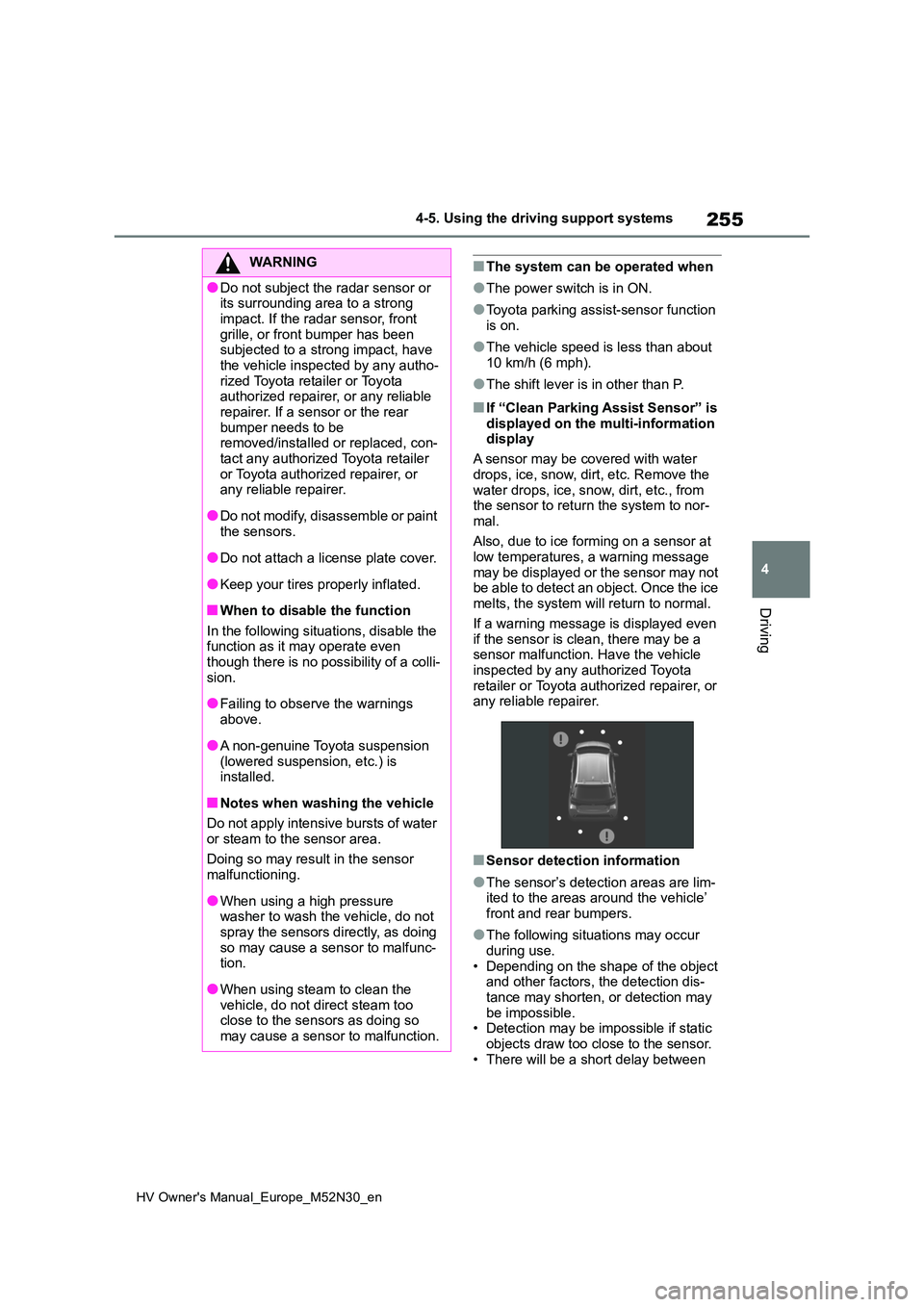
255
4
HV Owner's Manual_Europe_M52N30_en
4-5. Using the driving support systems
Driving
■The system can be operated when
●The power switch is in ON.
●Toyota parking assist-sensor function
is on.
●The vehicle speed is less than about
10 km/h (6 mph).
●The shift lever is in other than P.
■If “Clean Parking Assist Sensor” is
displayed on the multi-information display
A sensor may be covered with water
drops, ice, snow, dirt, etc. Remove the water drops, ice, snow, dirt, etc., from the sensor to return the system to nor-
mal.
Also, due to ice forming on a sensor at low temperatures, a warning message
may be displayed or the sensor may not be able to detect an object. Once the ice melts, the system will return to normal.
If a warning message is displayed even if the sensor is clean, there may be a sensor malfunction. Have the vehicle
inspected by any authorized Toyota retailer or Toyota authorized repairer, or any reliable repairer.
■Sensor detection information
●The sensor’s detection areas are lim-ited to the areas around the vehicle’
front and rear bumpers.
●The following situations may occur
during use. • Depending on the shape of the object and other factors, the detection dis-
tance may shorten, or detection may be impossible.• Detection may be impossible if static
objects draw too close to the sensor. • There will be a short delay between
WARNING
●Do not subject the radar sensor or its surrounding area to a strong
impact. If the radar sensor, front grille, or front bumper has been subjected to a strong impact, have
the vehicle inspected by any autho- rized Toyota retailer or Toyota authorized repairer, or any reliable
repairer. If a sensor or the rear bumper needs to be removed/installed or replaced, con-
tact any authorized Toyota retailer or Toyota authorized repairer, or any reliable repairer.
●Do not modify, disassemble or paint the sensors.
●Do not attach a license plate cover.
●Keep your tires properly inflated.
■When to disable the function
In the following situations, disable the function as it may operate even though there is no possibility of a colli-
sion.
●Failing to observe the warnings
above.
●A non-genuine Toyota suspension
(lowered suspension, etc.) is installed.
■Notes when washing the vehicle
Do not apply intensive bursts of water or steam to the sensor area.
Doing so may result in the sensor malfunctioning.
●When using a high pressure washer to wash the vehicle, do not spray the sensors directly, as doing
so may cause a sensor to malfunc- tion.
●When using steam to clean the vehicle, do not direct steam too close to the sensors as doing so
may cause a sensor to malfunction.